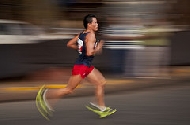Footstrike Patterns and Running Injury Rates
Posted by Rich Souza PT, PhD on April 8, 2013

The Starting Line:
Does foot strike pattern affect injury predisposition?
A recent study by Daoud and colleagues at Harvard University set out to determine the difference between rearfoot strike and forefoot strike on types and rates of injuries among runners. The study population consisted of 52 male and female, high-level intercollegiate track and cross-country runners, competing in distances ranging from 800 meters to 10 kilometers. None of the runners evaluated were midfoot strikers – all were either rearfoot or forefoot strikers.
The researchers observed more knee and hip injuries in the rearfoot strikers, while the forefoot strikers exhibited more ankle injuries. They also reported that rearfoot strikers were more than twice as likely to exhibit repetitive overuse injuries. Interestingly, females with a forefoot strike were more likely to develop Achilles tendinopathy, but males were not. Females with a rearfoot strike, however, were more likely to develop plantar fasciitis - and again males did not follow the same trend.
Across a variety of common overuse running injuries including knee pain and IT band syndrome, rearfoot-strikers were 2-3 times more likely than in the forefoot strikers. However, these differences were not statistically significant. This is one of the first studies to provide evidence that a particular strike pattern predisposes runners to more injuries. Despite this finding, the small sample size of the study means a larger cohort is needed before definitive conclusions can be made. Additinally, inclusion of midfoot strikers will be critical, as many recreational runners have adopted this running style. Nonetheless, Doud and colleagues have provided an important and promising contribution to the running literature.
The Finish Line:
Runners with rearfoot strikes tended to develop repetitive injuries and hip and knee injuries twice as often as forefoot strikers, suggesting that this running style may predispose runners to some running injuries.
References:
1. Daoud AI, Geissler GJ, Wang F, Saretsky J, Daoud YA, Lieberman DE. Foot strike and injury rates in endurance runners: a retrospective study. Med Sci Sports Exerc. 2012 44: 1325-34. http://www.ncbi.nlm.nih.gov/pubmed/22217561
Photo Credit: through my eyes only via photopin cc
*Note: This general information is not intended to be a substitute for medical treatment or advice. Always consult a professional before making changes to your health and wellness practices.
Feedback or suggestions for future topics? Let us know!

